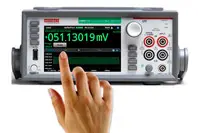Electronics News
Archive : 21 January 2015 год
Scientists from the University of Southampton's Optoelectronics Research Centre (ORC) have unveiled a technique that will allow more powerful, more energy efficient and low-cost pulsed lasers to be developed.
The approach is said to have a fundamentally different principle to that of existing pulsed lasers, relying upon the coherent combination of multiple semiconductor lasers, each operating continuous-wave at different precisely defined frequencies. With precise control of each laser's amplitude and phase, the team says it is possible to produce complex pulsed optical waveforms with a degree of user flexibility.
The key to making the approach work is to phase-lock the semiconductor lasers to an optical frequency comb, which ensures the individual lasers have well-defined mutual coherence.
Many applications that require optical pulses typically need waveforms with a specific repetition rate, pulse duration and shape. Designing a laser to meet these parameters is challenging and, even when a suitable solution exists, size, complexity and ease of operation are further considerations.
Researcher David Wu said of the approach: "It consists of miniature and low cost semiconductor lasers that can all be integrated on the same chip, making our pulse generator potentially very compact, robust, energetically efficient and low-cost."
Author
Graham Pitcher
Source: www.newelectronics.co.uk
 Lasers, displays and other light emitting depend upon the electrically controlled modulation of photons. But, says a research team, electrical control of the light emission pathways opens up the possibility of novel types of nano photonics devices, based on active plasmonics.
Lasers, displays and other light emitting depend upon the electrically controlled modulation of photons. But, says a research team, electrical control of the light emission pathways opens up the possibility of novel types of nano photonics devices, based on active plasmonics.
Scientists from ICFO, MIT, CNRS, CNISM and Graphenea have demonstrated active electrical control of the energy flow from erbium ions into photons and plasmons. The experiment was implemented by placing the erbium emitters a few nanometres from a graphene sheet, whose carrier density – or Fermi energy – is controlled electrically.
Erbium ions emit light at a wavelength of 1.5µm – the third telecom window. This is important for optical telecommunications because there is little energy loss in this range, and so data transmission is highly efficient.
The team has shown that the energy flow from erbium into photons or plasmons can be controlled simply by applying a small electrical voltage. As the Fermi energy of the graphene sheet was increased, the erbium emitters went from exciting electrons in the graphene sheet to emitting photons or plasmons. The experiments revealed graphene plasmons at near infrared frequencies, relevant for these telecommunications applications. In addition, the strong concentration of optical energy is said to offer potential for data storage and manipulation through active plasmonic networks.
Author
Graham Pitcher
Source: www.newelectronics.co.uk
 TDK-Lambda UK has been awarded a patent by the UK Intellectual Property Office for a novel power supply heat sink arrangement.
TDK-Lambda UK has been awarded a patent by the UK Intellectual Property Office for a novel power supply heat sink arrangement.
According to the company, the various components in a power supply that dissipate heat require different cooling arrangements and a combination of both surface mount and leaded
components is generally required.
"Available space and electrical clearance was an issue," said Martin Coates, senior electrical design engineer with TDK-Lambda. "We needed a cost effective hybrid solution."
That solution supports both leaded and surface mount components. It uses a traditional IMS board, with surface mounted power components on one side and leaded power semiconductors on the other side. These leaded devices are attached with double sided adhesive tape that offers insulating and thermally conductive properties.
The completed space saving assembly does not use any mechanical fasteners and can be soldered to the main circuit board.
Author
Graham Pitcher
Source: www.newelectronics.co.uk
 Keithley Instruments has unveiled Model DMM7510, a 7½ digit graphical sampling multimeter, said by the company to be the first of a new class of digital multimeters.
Keithley Instruments has unveiled Model DMM7510, a 7½ digit graphical sampling multimeter, said by the company to be the first of a new class of digital multimeters.
It integrates a high accuracy digital multimeter, a digitiser for waveform capture and a capacitive touchscreen user interface. The device is designed to give users confidence in the accuracy of their results, as well as the ability to explore measurements further.
Jerry Janesch, senior market development manager, noted: "To get an in depth understanding of their devices under test, engineers need to capture small signals at higher accuracy and faster speeds than traditional DMMs can provide. Model DMM7510's intuitive operation and high speed digitiser allow it to address a wide range of test applications."
Model DMM7510 offers users a precision multimeter, with resolution selectable from 3½ to 7½ digits, a 1Msample/s 18bit digitiser and interactivity via a 5in capacitive touchscreen interface.
Author
Graham Pitcher
Source: www.newelectronics.co.uk

